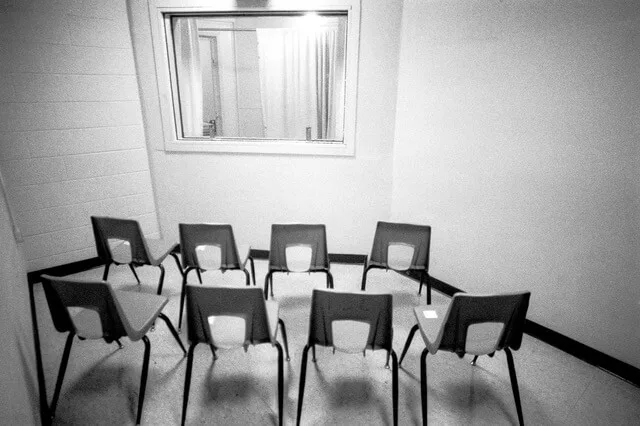
The observation room for Central Prison's execution chamber. (Photo via Scott Langley of deathpenaltyphoto.org)
A new report from a leading anti-death penalty group explains how North Carolina’s existing death penalty was born from the state’s brutal and racist history.
Editor’s note: The following is an excerpt from the Center for Death Penalty Litigation’s new report, “Racist Roots: Origins of North Carolina’s Death Penalty.”
Andrew Ramseur was a young Black man accused of killing two white people, and the white citizens of Iredell County were clamoring for a lynching.
In public forums, they spewed racist epithets and called Andrew a “beast” and a “monkey.” They barraged newspapers with comments like, “He should be hanging from the nearest traffic light as a warning to the rest.” Instead of condemning the racist furor, the district attorney quickly promised the death penalty.
A few months later, Andrew’s family arrived at the courthouse for his trial. Outside, a crowd of angry white people massed in the shadow of a Confederate monument. Inside, crime scene tape inexplicably blocked the rows of seats behind Andrew, forcing his family to sit in the back. In a courtroom where every lawyer, judge and juror was white, they watched a jury sentence Andrew to death.
Andrew Ramseur’s trial might sound like something out of the distant past, but it happened in 2010.
He is among the newer residents of North Carolina’s death row, which houses about 140 people sentenced to execution since 1985.
The lawmakers, prosecutors, and judges who run the bureaucracy of death in North Carolina may imagine that today’s death penalty has no relation to the state’s brutal history of racial terror and legalized oppression. But the truth is, despite decades of efforts to reform the death penalty, the past is written all over the present.
The Death Penalty’s Roots
Imagine North Carolina’s death penalty as a sturdy tree. It grew from a seed planted in the soil of slavery. In the beginning, it was used to ruthlessly enforce the dominance of enslavers. It matured in the years of Jim Crow, when Black people, including children, were frequently sentenced to death under the watchful eyes of lynch mobs, who were ready to do the job themselves if the all-white jury didn’t do it for them.
In the early 1970s, the death penalty was struck down by the U.S. Supreme Court, but don’t mistake this period for an uprooting; it was merely a pruning of the death penalty’s most glaring excesses. In 1976, North Carolina revived the death penalty under new laws. It surged with new growth, delivering a fresh bounty of death sentences handed down by overwhelmingly white juries to impoverished defendants, the majority of whom were people of color.
Today, people of color make up less than thirty percent of North Carolina’s population but sixty percent of its death row. Black defendants are far more likely to be wrongly convicted.
Of the ten death-sentenced people who’ve been exonerated and released in North Carolina, only one was white. The rest were Black or Latino men.
Yet, the targeting of Black defendants is far from the only way that racism permeates the North Carolina death penalty. Nearly half the people on death row had an all-white jury or a jury with only a single person of color. Rigorous statewide studies show that prosecutors strike Black jurors from capital juries at two and a half times the rate of white jurors.
When it comes to the death penalty, white lives matter. Defendants are twice as likely to be sentenced to death if they’re accused of killing a white person.
More than three quarters of people executed under current North Carolina laws were executed for killing a white person.
Certainly, the death penalty looks different today than it did in the past. In the nineteenth century, executions were carried out by county sheriffs on public hanging grounds. Thousands of white spectators traveled to picnic, drink, and cheer the death of a Black man at the end of a noose.
In the early twentieth century, as North Carolina sought to burnish its reputation in a modernizing world, the death penalty became more controlled and sanitized.
The state took over executions and hid them behind the walls of Raleigh’s Central Prison. It worked to find new methods of killing that were less gruesome for spectators. It built an electric chair, then a gas chamber, and then moved to the sterile and medicalized injection of poison into the veins of a prisoner strapped to a gurney and draped with a clean, white sheet.
But the goal was always to preserve the death penalty, to disguise its true motives and its brutality. The goal was never to root out and destroy the racism on which it feeds.
State Control of Black Lives
In what we call the “modern” era, the death penalty continues to achieve exactly what it was intended to do when it began: Punish the powerless and cement the supremacy of the powerful. It remains the ultimate symbol of state control.
It makes Black men the face of violence, while obscuring the fact that throughout American history, white people carried out a sustained campaign of racial terror. It allows society to see an impoverished defendant accused of a single crime as a monster, even as that society fails to hold wealthy people accountable for crimes that cost lives on a much larger scale — corporate fraud and greed, financial scams, environmental degradation, even torture.
The death penalty today is the apex of a criminal punishment system that cages nearly 70,000 people in North Carolina, including children as young as 11 years old.
A system that separates families, blights communities of color, and consumes unfathomable quantities of public resources. A system that has turned a blind eye to police brutality and normalized the killings of Black people.
In the past decade, the number of new death sentences has declined, but the death penalty remains a potent force skewing the system toward extreme punishments. Police and prosecutors still routinely use the threat of execution to pressure people accused of crimes into accepting plea bargains. Many defendants give up their constitutional right to a trial and accept death by incarceration, otherwise known as a sentence of life with no possibility of parole, all because the state threatened to seek the death penalty if the case went to trial.
NC Needs to Abolish the Death Penalty
Even as protests rage over the excesses of the criminal punishment system, North Carolina still spends millions each year trying to execute people, and statewide politicians of both parties still proclaim their support for capital punishment. In all these years of state-sponsored killing, North Carolina’s leaders have rarely paused to consider whether a state that enslaved human beings, lynched people, let the Ku Klux Klan run rampant, and sent children to the execution chamber ought to have a death penalty at all.
And not just a death penalty, but one that continues to target Black and brown people at disproportionate rates. One that continues to favor white jurors and value white victims. One that continues to be run almost entirely by white judges, lawyers, administrators, and law enforcement officers. In most courtrooms today, lawyers and judges engage in the fiction that the system is color-blind as they blithely send another poor Black man to prison.
However, Andrew Ramseur’s case is one of many in which the death penalty’s race-neutral facade cracks open and reveals its true nature.
As cries for racial justice sound in the streets, North Carolina’s leaders say they will examine the impact of racism on criminal justice. Governor Roy Cooper formed the North Carolina Task Force for Racial Equity in Criminal Justice, chaired by the state attorney general and a state Supreme Court justice. If the task force is serious about its work, it must reckon with the death penalty, a remnant of slavery that perpetuates its legacy of terror.
Just like a Confederate monument, the death penalty has always been a symbol of white supremacy.
Now, there is only one thing left to do with this poisoned tree. Dig it up and salt the earth. Never again assert the state’s power to kill any human being.

Op-Ed: Studying the Holocaust remains vital to ensuring it never happens again
International Holocaust Day will be observed on January 27, 2024. This day commemorates the liberation of the Auschwitz concentration camp by the...

VIDEO: How Rural Broadband Is Coming to This North Carolina County
More than 1.1 million North Carolinians lack access to high-speed internet, a necessity of the modern economy. In Warren County, help is on the way,...

VIDEO: Sampson County puts Biden’s promise to boost rural infrastructure to the test
Locals in this rural NC county say their water and air is polluted by a PFAS-contaminated landfill, massive hog and poultry farms, and industrial...

VIDEO: Sampson County puts Biden’s promise to boost rural infrastructure to the test
Locals in this rural NC county say their water and air is polluted by a PFAS-contaminated landfill, massive hog and poultry farms, and industrial...

Mold and classes in trailers: Inadequate funding for schools is hurting NC communities
Schools across the state are dealing with dilapidated classrooms and buildings in need of significant repair or a total rebuild due to a lack of...







